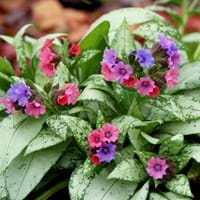Life Span
Perennial
Perennial
Origin
North America, Canada, Mexico
Hybrid origin
Types
Bigleaf hydrangea, Hortensia, Smooth hydrangea, Oakleaf hydrangea, Annabelle
Benediction lungwort, Excalibur lungwort
Habitat
Forest edges, Hillside, Woods
Forest edges, Mountains
USDA Hardiness Zone
Not Available
4-8
Sunset Zone
1a, 1b, 2a, 2b, 3a, 3b, 4, 5, 6, 7, 8, 9, 10, 11, 14, 15, 16, 17, 18, 19, 20, 21, 22, 23
1a, 1b, 2a, 2b, 3a, 3b, 4, 5, 6, 7, 8, 9, 14, 15, 16, 17
Habit
Upright/Erect
Cushion/Mound-forming
Flower Color
Blue, Dark Purple, Light Purple, Red, White
Pink, Rose, Blue Violet
Flower Color Modifier
Bicolor
Not Available
Fruit Color
Not Available
Not Available
Leaf Color in Spring
Green, Light Green, Blue Green, Gray Green
Green, Gray Green, Silver
Leaf Color in Summer
Light Green
Green, Gray Green, Silver
Leaf Color in Fall
Red, Green, Orange, Blue Green, Gray Green, Bronze
Green, Gray Green, Silver
Leaf Color in Winter
Tan, Sandy Brown
Light Green
Leaf Shape
Oblovate
Lung shaped
Plant Season
Spring, Summer, Fall, Winter
Spring, Summer, Fall
Sunlight
Full Sun, Partial Sun
Partial Sun, Partial shade, Full Shade
Type of Soil
Clay, Loam, Sand
Clay, Loam, Sand
The pH of Soil
Acidic, Neutral, Alkaline
Acidic, Neutral, Alkaline
Soil Drainage
Average
Well drained
Bloom Time
Early Summer, Summer, Late Summer
Early Spring, Spring, Late Winter
Tolerances
Pollution, Soil Compaction
Drought
Where to Plant?
Container, Ground
Ground
How to Plant?
Seedlings, Stem Planting
Divison, Seedlings
Plant Maintenance
Medium
Medium
Watering Requirements
Not Available
Water when soil is dry, when new, water every week
In Summer
Drought Tolerant, Average Water
Drought Tolerant
In Spring
Moderate
Average Water
In Winter
Average Water
Adequately
Soil pH
Not Available
Acidic, Neutral, Alkaline
Soil Type
Not Available
Clay, Loam, Sand
Soil Drainage Capacity
Not Available
Well drained
Sun Exposure
Not Available
Partial Sun, Partial shade, Full Shade
Pruning
Remove damaged leaves, Remove dead branches, Remove dead leaves
Remove damaged leaves, Remove dead branches, Remove dead leaves
Fertilizers
All-Purpose Liquid Fertilizer
All-Purpose Liquid Fertilizer
Pests and Diseases
Red blotch
Powdery mildew, Slugs
Plant Tolerance
Pollution, Soil Compaction
Drought
Flower Petal Number
Single
Single
Foliage Texture
Fine
Coarse
Foliage Sheen
Not Available
Matte
Invasive
Not Available
No
Self-Sowing
Not Available
Yes
Attracts
Bees, Flies
Not Available
Allergy
Chest tightness, Diarrhea, Dizziness, Nausea, Vomiting
Not Available
Aesthetic Uses
Not Available
Showy Purposes
Beauty Benefits
Not Available
Not Available
Edible Uses
Not Available
Yes
Environmental Uses
Air purification
Air purification, Provides ground cover
Medicinal Uses
Fever, Kidney problems, Urinary tract problems
Astringent, Demulcent, Diaphoretic, Diuretic, Emollient, Exoectorant, Homeopathy, Opthalmic, Resolvent
Part of Plant Used
Flowers, Root
Leaves
Other Uses
Not Available
Used for its medicinal properties
Used As Indoor Plant
Not Available
No
Used As Outdoor Plant
Yes
Yes
Garden Design
Not Available
Edging, Groundcover, Mixed Border, Rock Garden / Wall
Botanical Name
PANICUM virgatum 'Northwind'
PULMONARIA 'Berries and Cream' PP10597
Common Name
Northwind Switchgrass, Switchgrass
Berries and Cream Lungwort, Lungwort
In Hindi
Hydrangea
Lungwort
In German
Hortensie
Lungenkraut
In French
Hortensia
pulmonaire
In Spanish
Hortensia
Lungwort
In Greek
υδραγεία
Lungwort
In Portuguese
Hortênsia
pulmonária
In Polish
Hortensja
płucnik
In Latin
Hibiscus
Lungwort
Phylum
Not Available
Ascomycota
Class
Not Available
Ascomycetes
Order
Not Available
Peltigerales
Family
Not Available
Boraginaceae
Genus
Not Available
Pulmonaria
Clade
Not Available
Angiosperms, Asterids, Eudicots
Tribe
Not Available
Boragineae
Subfamily
Not Available
Boraginoideae
Number of Species
Not Available
Season and Care of Northwind Switchgrass and Lungwort
Season and care of Northwind Switchgrass and Lungwort is important to know. While considering everything about Northwind Switchgrass and Lungwort Care, growing season is an essential factor. Northwind Switchgrass season is Spring, Summer, Fall and Winter and Lungwort season is Spring, Summer, Fall and Winter. The type of soil for Northwind Switchgrass is Clay, Loam, Sand and for Lungwort is Clay, Loam, Sand while the PH of soil for Northwind Switchgrass is Acidic, Neutral, Alkaline and for Lungwort is Acidic, Neutral, Alkaline.
Northwind Switchgrass and Lungwort Physical Information
Northwind Switchgrass and Lungwort physical information is very important for comparison. Northwind Switchgrass height is 150.00 cm and width 90.00 cm whereas Lungwort height is 25.50 cm and width 30.50 cm. The color specification of Northwind Switchgrass and Lungwort are as follows:
Northwind Switchgrass flower color: Blue, Dark Purple, Light Purple, Red and White
Northwind Switchgrass leaf color: Green, Light Green, Blue Green and Gray Green
Lungwort flower color: Pink, Rose and Blue Violet
- Lungwort leaf color: Green, Gray Green and Silver
Care of Northwind Switchgrass and Lungwort
Care of Northwind Switchgrass and Lungwort include pruning, fertilizers, watering etc. Northwind Switchgrass pruning is done Remove damaged leaves, Remove dead branches and Remove dead leaves and Lungwort pruning is done Remove damaged leaves, Remove dead branches and Remove dead leaves. In summer Northwind Switchgrass needs Drought Tolerant, Average Water and in winter, it needs Average Water. Whereas, in summer Lungwort needs Drought Tolerant and in winter, it needs Adequately.




